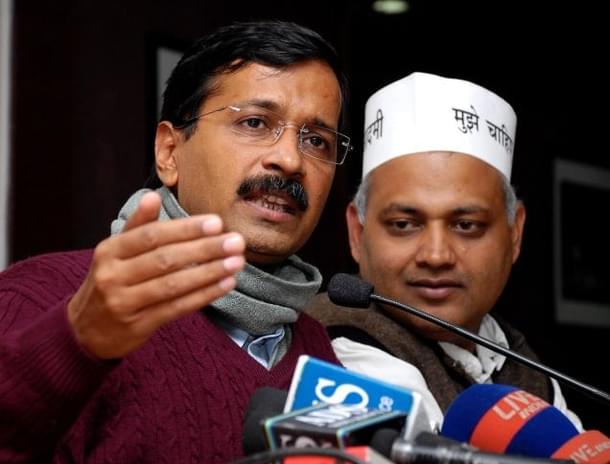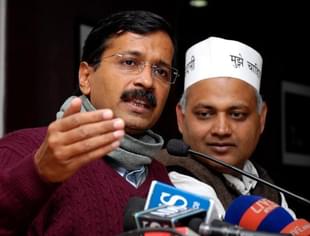Politics
Why MCD Polls Won’t Be A Repeat Of The 2015 Assembly Elections
Shoumendu Mukherji
Apr 09, 2017, 12:29 PM | Updated 12:29 PM IST
Save & read from anywhere!
Bookmark stories for easy access on any device or the Swarajya app.


The bugle for the Municipal Corporation of Delhi (MCD) elections had been sounded with the pompous announcement of Delhi’s Chief Minister Arvind Kejriwal that on being voted to power, Delhi will be transformed into London in a year. As silly as this statement sounded, it reflected the repetitive disposition of our politicians to highlight the Western world as the cynosure of development and administration.
The density of Delhi's population (at 11,297 persons per sq km) is more than double the density of London (5,491 persons per sq km). Consumer prices including rent in London are 267.86 per cent higher than in Delhi, and London is home to over three million foreigners.
It will be wise if we end the comparison of similarities between the two cities at the Ferris Wheel (Delhi’s very own Delhi Eye stands at Kalindi Kunj) and the 76-year “Ghantaghar” at Sabzi Mandi area (though not as famous as the iconic Big Ben).
Civic issues are best catered keeping in mind local demographics and limitations.
Delhiites will vividly remember how parachuting the Bus Rapid Transit (BRT) formula from Bogota, Columbia (a city with one-third the population density of Delhi) bombed. Kejriwal with his impractical suggestions is once again painting an idealist imagery to grab votes.
However, this city having already witnessed two years of his misrule, the results this time around are unlikely to be as one-sided as the Assembly elections.
After resigning as Chief Minister on 14 February 2014 and seeking re-elections on the pretext that he did not have enough numbers in the legislative assembly to pass the Jan Lokpal bill, the Arvind Kejriwal-led Aam Aadmi Party (AAP) received a massive mandate winning 67 out of 70 seats on 7 February 2015. Surprisingly, there was not a whisper of tampering of electronic voting machines back then.
Voters were convinced that the newest political party, at that time having blessings of Anna Hazare, deserved a second chance to fulfil its populist commitments.
Voters deemed it necessary to create a new opposition replacing the Congress Party which was still recovering from its Lok Sabha debacle. The Bharatiya Janta Party (BJP), underestimating the undercurrents, also played into AAP’s hands by choosing a weak chief ministerial candidate. Unfortunately, this excitement and positive anticipation amongst Delhi voters were misused in the months that followed.
There is a popular maxim in law, “Ignorantia Juris Non Excusat” which means, “ignorance of the law is no defence”. Despite having won the election, AAP’s frequent attempts at sidestepping constitutional provisions and dodging the administrative supremacy of the Lieutenant Governor reflected poorly on the magnanimity and humility required to accept the uniqueness of Delhi.
Expelling its two senior-most leaders in its early stages of government, signalled that a sense of arrogance had already crept onto the party leadership.
Having chest-thumped his way to victory on the anti-corruption plank, it was antithetical to see the Chief Minister staunchly defend his health minister, Satyendra Jain who, as director of certain companies, received Income Tax notices for having links with hawala operators. It was disheartening to see him defending his law minister Jitender Tomar who kept claiming his fake law degree as genuine.
The condition of roads in Delhi has crumbled due to lack of maintenance; the DTC fleet of buses is miraculously breathing its last every day in dire need of upliftment, the promise of 500 new schools is still waiting to see the light of the day and let’s not even go to the Wi-fi promise.
The once “clean” image of Arvind Kejriwal has been distorted by him joining hands with political veterans such as Nitish Kumar (whose government is supported by scam-tainted Lalu Prasad Yadav) and Mamata Banerjee who has her hands full covering for scam-tainted legislators accused in the Sharada and Rose Valley chit fund scams.
Calling the Prime Minister a “coward and a psychopath” has further deteriorated his dignity.
It would be fair to say that the Bharatiya Janta Party in 2014-15 was still into the early days of its tenure and could not quite consolidate the limited achievements of its central schemes during the year-long President’s Rule. The big bang reforms were yet to transpire.
In stark contrast, recent times have witnessed the BJP notch up unprecedented results at the local level in the panchayat elections in Odisha (improving its tally by 850 per cent vis-a-vis 2012) and the Brihanmumbai Municipal Corporation (BMC) elections.
On the other hand, AAP’s ambition of becoming a national party from a mere regional force has received a massive jolt with shattering losses in the Goa assembly elections and a disappointing second position in Punjab, despite its exhaustive campaigning for almost a year.
Does this indicate that voters have already begun to distrust AAP’s policies and governance model? Even the Congress which was wiped out in 2015 has somewhat resurrected its identity with the Punjab win. Captain Amarinder Singh has been roped in to lead the party and repeat its domination over Aam Aadmi Party. A truly three-way fight awaits for supremacy over the second richest municipal corporation after Mumbai.
AAP must ideally reinvent itself in these polls as the same old rhetoric of ‘everyone around is corrupt except my party and people’ will not quite gain traction among people this time around.
The landslide result of 2015 most likely will remain a flash in the pan, being the one and only pinnacle spot of its short yet vociferous rule.
The families and legacies that have been voting for the Congress since generations, but had pledged their allegiance to AAP for Vidhan Sabha 2015 in all likelihood will shift camps once more back to the Congress, on the back of their disappointment at AAP’s no-show. Such probability is sure to bolster the hopes of the Congress campaigners.
This sense of optimism of the traditional Congress voters is also being furthered by a ray of optimism that their party would have shed its arrogance and picked up the pieces after its repeated losses across the country.
There is also a palpable concern which the Congress should concertedly avoid if it performs strongly in these polls i.e. avoid partaking the legacy of Arvind Kejriwal in being the chef de mission for hurling brickbats at Narendra Modi.
On the other hand, Delhi voters may be eager to be part of the BJP juggernaut that has already swept 17 legislative assemblies.
As ironic as it may sound, the reason why AAP was able to romp home in 2015 is exactly the position in which the BJP is at present i.e. seeking a second opportunity from the Delhi voter for making good its past wrongs, looking to secure a firm mandate for ringing in radical policy changes, and keeping a check on a rising “behemoth”.
Although, “behemoth” may be too heavy a word to be used for AAP’s 67 to 3 majority in the assembly, yet AAP’s attempts at altogether giving up on its responsibility towards Delhi (a CAG report recently found that Rs. 28 crore of Delhi taxpayers’ money was used for AAP’s publicity outside Delhi) deserves to be made accountable.
With a BJP win, Modi – Shah will look to shake up the municipality for good. Cleanliness and civic issues having been core components of the Centre’s policies ever since 2014, so I doubt there is much to be questioned about the intentions.
This April, it is the BJP’s big golden opportunity to make things right with the Delhi voter.





